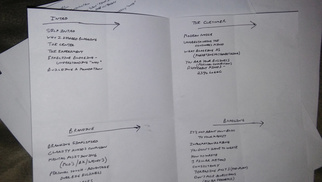 So the time has come when you have to stand up in front of a group of people and speak. This could be a simple presentation for school, on your job or for your business. I figured since this is part of what I do on occasion, I would throw in my 10 cents. What I want to present in this post is a very simple method that anyone can use when trying to design an overall message they need to get across verbally to an audience. Designing and planning what you want to say and the order you want to say it in, is not that difficult although it does take planning. There are just 2 things you need to remember throughout this entire process: (1) What is the overall message? When it’s all said and done, what is it you want your audience to take away? Do you want them to learn something? Do you want them to consider something? Or you trying to change their opinion about a subject? Are you just sharing what you know? Are you trying to teach them an easier way to do something? (2) How much time are you working with? This is very important because we want to hit ALL our main points (which I’ll discuss in a moment) within this time frame. Plus we need an introduction and closing. Depending on what type of speaking engagement you’re doing, you may also have to make time for a questions and answers session. The formula is real simple. Let’s say you have 3 Main Points you want to make and you have 30 minutes total to speak. The 3 Main Points should take around 8 minutes each – 24 minutes total (3 X 8 = 24). This leaves 6 minutes remaining (30 – 24 = 6). These 6 left over minutes could be divided – 3 minutes for an introduction and 3 minutes for a closing. Keeping track of your timing is easy than ever now because there are mobile apps that will vibrate or chime at certain time intervals you set. You can also purchase laser pointers that have this functionality built in. If you don’t want to get this fancy, just set a stopwatch function on your cell phone, start it when you begin your introduction and place it where you can see it.  ***THE FLOW*** Every speaking engagement only really has 3 pieces: (1) Tell them what you’re about to tell them: Introduce who you are, why you’re speaking and set-up what you’re going to speak about. (2) Tell them: Present the points you want to make in a logical and easy to follow order. (3) Tell them what you’ve just told them: Briefly summarize what you just spoke about. Give out your thank yous and lastly plug your website, social media info, etc. SIDE NOTE: If you’re doing questions and answers, do these BEFORE your closing remarks. This lets your audience know that the discussion is still “open”. This will also make the last thing they hear from you be your actual contact information. This is not a “rule”, so it really depends on your audience. ***THE STRUCTURE*** First and foremost you need a MAIN TOPIC. What do you plan on speaking (or teaching) about? This is the entire purpose of your speaking engagement. Next you need to divide up your MAIN TOPIC into a few Main Points that you want to make. To keep things simple I suggest having only 3 Main Points to speak about. These could be 3 different ways to do something. Or maybe they could be, (1) background information, then (2) how to use that information, then (3) how to maximize the effects of that information. The idea here is that you want to take the listener’s hand and walk them step-by-step through everything you have to say. Finally, you want to make sure that each of your 3 Main Points are supported by facts, statistics, personal experiences, experiences of others, stories, credentials, etc. These are your PROOFS (or evidence) that can back up what you’re saying (or teaching). Think of it like this: Your SUPPORTING PROOFS (facts, statistics, stories, etc.) are the “foundation” that hold up your 3 Main Points. Your 3 Main Points are “pillars” that hold up the “roof” which is your MAIN TOPIC. It’s a solid structure – everything is held up by your PROOFS (support). If these are weak, then everything else doesn’t matter because WHY should people listen to you?  I'm Still Old School! Here Are Early Notes For The Training I'm Doing This Month I'm Still Old School! Here Are Early Notes For The Training I'm Doing This Month A simple example: Let’s say I want to speak about, “How to Be a Better Parent”. This is my MAIN TOPIC (the roof). There are 3 Main Points I want to make; those are (1) Children need to be shown that they’re important, (2) Children need to be prepared for the real world, (3) Children need boundaries to help shape productive, not destructive, behavior (these are pillars that hold up my roof). And then I would find studies, facts, statistics, personal stories, other people’s stories, experiences and other PROOFS (the foundation which holds up my pillars) to support each of these 3 Main Points. ***PUTTING IT ALL TOGETHER*** So now that you have a lot of notes. How do you turn them into an actual presentation? Very simple, go back to the section on, “THE FLOW”. You plan out an introduction and explain why this topic is important to you AND your audience. You can also tell them the 3 Main Points you’re going to cover. Also give out your personal credentials (if you have any). From there, lead into the “meat” of the presentation – your 1st Main Point – state the problem(s), then the solution(s). Back this up with any relevant PROOFS (support). Then you smoothly transition into your 2nd Main Point in the same fashion and then move on to the 3rd. Remember, you only have a certain amount of time to present each Main Point, so make sure you can get everything out proficiently within your time constraints. Lastly, plan out your closing. Here you briefly reemphasize (or summarize) the 3 Main Points, say your thank yous and give out your contact information. You can write all this out on a piece of paper then divide it up into index cards. If you’re very confident and knowledgeable in what you’re going to speak about, you can simply remember THE FLOW and THE STRUCTURE and fill-in the rest of the details in your mind (this is not as easy – please don’t use this method as a way to be lazy because you don’t want to put in the necessary work). After all this has been done, you can then design any slides, hand-outs, or anything else you want to use for your presentation. There you have it. A very simple and straight-forward method you can use for any speaking engagement or presentation. It’s easy and it works. Of course this isn’t everything you need to know, but this will be a great starting point. This is also good for someone who just needs to put a quick, one-time, 15-20 minute presentation together. Questions? Email me at: [email protected] On Saturday, March 12th, catch me in a live training as I teach a proven and time-tested method to make more money in your business - whether online, offline or both! Click [HERE] for details.
0 Comments
Leave a Reply. |
Author
|





 RSS Feed
RSS Feed
